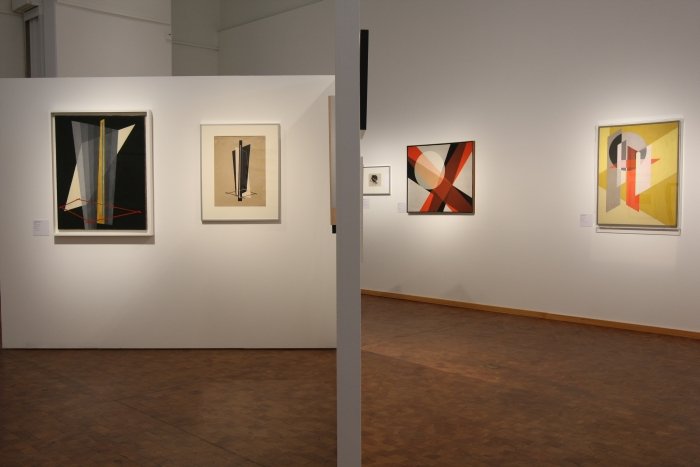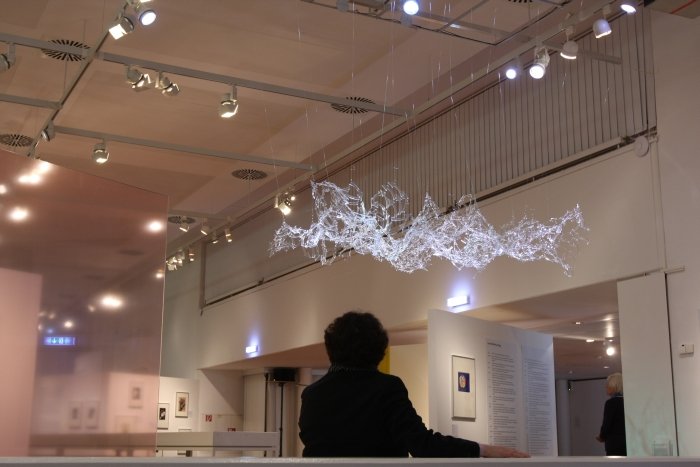In his 1936 film "Modern Times" Charlie Chaplin is famously swallowed by the wheels of progress in a short yet cutting critique on the problems and challenges technological and social change were bringing for the common man.
Over a decade earlier the Hungarian artist and author László Moholy-Nagy had also began to approach and study the problems and challenges of modernity, of increasing technological innovation and the associated flood of new sensory experiences, and in their winter 2014/15 exhibition "Sensing the Future: László Moholy-Nagy, die Medien und die Künste" the Bauhaus Archive Berlin present an in-depth exploration of not only László Moholy-Nagy's work in this field, but also the continuing relevance of that work in our own "Modern Times"

Born in 1895 in Bácsborsód, Hungary László Moholy-Nagy initially intended to follow a legal career, before his plans changed upon discovering avant-garde art and literature, first through the Budapest "Activist" movement and subsequently Dadaism and Russian Constructivism. In 1920 László Moholy-Nagy moved to Berlin where in addition to being introduced to the ideas of the progressive education movement he published his first, programmatic, texts and participated in his first art exhibitions, before in 1923 Walter Gropius appointed him to replace Johannes Itten as tutor for the famous introductory Vorkurs at Bauhaus Weimar. Having moved with the institution from Weimar to Dessau László Moholy-Nagy left Bauhaus in 1928 to establish his own design studio in Berlin before, and as with so many of his contemporaries, the rise to power of the NSDAP saw him emigrate: firstly to Amsterdam, then London, Brno and ultimately Chicago. In 1937 László Moholy-Nagy attempted to revive the Bauhaus spirit with the so-called "New Bauhaus" college in Chicago, an ill-fated adventure which lack of funds forced to closed in 1938, whereupon László Moholy-Nagy established the Chicago School of Design which ultimately became the contemporary Illinois Institute of Technology Institute of Design. László Moholy-Nagy died in Chicago on November 24th 1946.
Initiated and curated by Professor Oliver Botar from the University of Manitoba's School of Art "Sensing the Future" seeks to explore how in his work, artistic and educational, László Moholy-Nagy sought to both understand the exponential technological changes taking place in the 1920s and also help the population at large prepare for and deal with the coming future, for all the coming medial future. "László Moholy-Nagy felt that art was the best way to help people deal with this onslaught of sensory inputs", explains Oliver Botar, "on the one hand by teaching us how to use our senses to their full capacity, but also through art itself. He felt that if you made art that was sensory challenging, then this challenge, in a controlled situation, could be an arena to help people adapt better to the changes of the period."
And so just as Fritz Haller designed a space colony to help him think more clearly about terrestrial architectural and urban planning problems, so did László Moholy-Nagy consider that creating an artificially challenging environment would help us understand and adapt to evolving technological realities.
An example of how László Moholy-Nagy understood this role and function of art can be seen is his Poly-Cinema, a "film projection space" in which several films are played at once on a curved projection surface; a concept which initially overpowers the viewer but which also challenges you to find a way to control the information flood and so bring order to the chaos. Sensing the Future features a reconstruction of a Poly-Cinema thus allowing all visitors the chance to do just that.
And at the same time understand that the issues facing László Moholy-Nagy and his contemporaries are just as relevant now as they were then: increasing and more rapid reproducibility through new media, new production processes, advertising, globalisation. László Moholy-Nagy may not have had to worry about ever new apps, 3D printing or virtual viruses; but he did have photography, film and the motor car.

In addition to helping society understand the future László Moholy-Nagy also considered how new technology could be used to help us adapt. One such consideration was his so-called "Konstruktionsorgel" - Construction Organ - a replica of which is included in the exhibition. In a 1938 presentation of the Konstruktionsorgel László Moholy-Nagy argued that because visual images would become ever more important, that communication with and via visual images would become a daily occurrence, yet because the costs of photography were prohibitively high, those without access to the tools of photography, and such experience in composing and creating graphics, would become the illiterate of the future world. Consequently technical aids were required to make access to visual composition available to all. The Konstruktionsorgel is his solution. In effect it is Photoshop. In 1938. With the images saved on punch cards. It is also a wonderful analogy for the modern situation with smartphone and mobile computer technology: those who don't have access risk being left behind. Or at least not able to open hotel doors, book concert tickets or find out when the next train departs.
These days we are probably more likely to turn to designers for solutions to social and cultural problems, one of the more durable legacies of Bauhaus being the development of design from art via applied art. But does art still have a role to play in helping us understand our environment. Or have we moved on?
"I think art is still very important in this regard", answers Oliver Botar unequivocally, the impetus however is on the artist to take the initiative, to understand the world around them and the nature of the changes taking place, as László Moholy-Nagy once did. "László Moholy-Nagy said that artists have to engage with all new technology, regardless of what it is", continues Oliver Botar, "artists shouldn't be afraid of technology and should collaborate with technicians. If artists can do it, that gives us all the courage and confidence to engage with new technology."
To this end Sensing the Future features, in addition to paintings, sculptures, plans, installations, photographs and films by László Moholy-Nagy, contemporary works produced by contemporary artists which continue the spirit of László Moholy-Nagy's philosophy.
A very open and clearly designed exhibition Sensing the Future not only provides an excellent introduction to László Moholy-Nagy but also helps us understand that despite how quickly we may think our current society is progressing and changing, it isn't progressing and changing any quicker than society was for a 100 years. And consequently we can learn a lot from previous generations about adapting to new technology and new futures.
"László Moholy-Nagy felt it was very important that we controlled technology lest we be controlled by technology", adds Oliver Botar, "That was his basic message and I feel that message is relevant today because we all feel occasionally overwhelmed"
And all occasionally get sucked into the machinery à la Charlie Chaplin.
Sensing the Future: László Moholy-Nagy, die Medien und die Künste runs at the Bauhaus Archiv, Klingelhöferstrasse 14, 10785 Berlin until Monday January 12th 2015.
Full details, including information on the accompanying fringe programme can be found at www.bauhaus.de